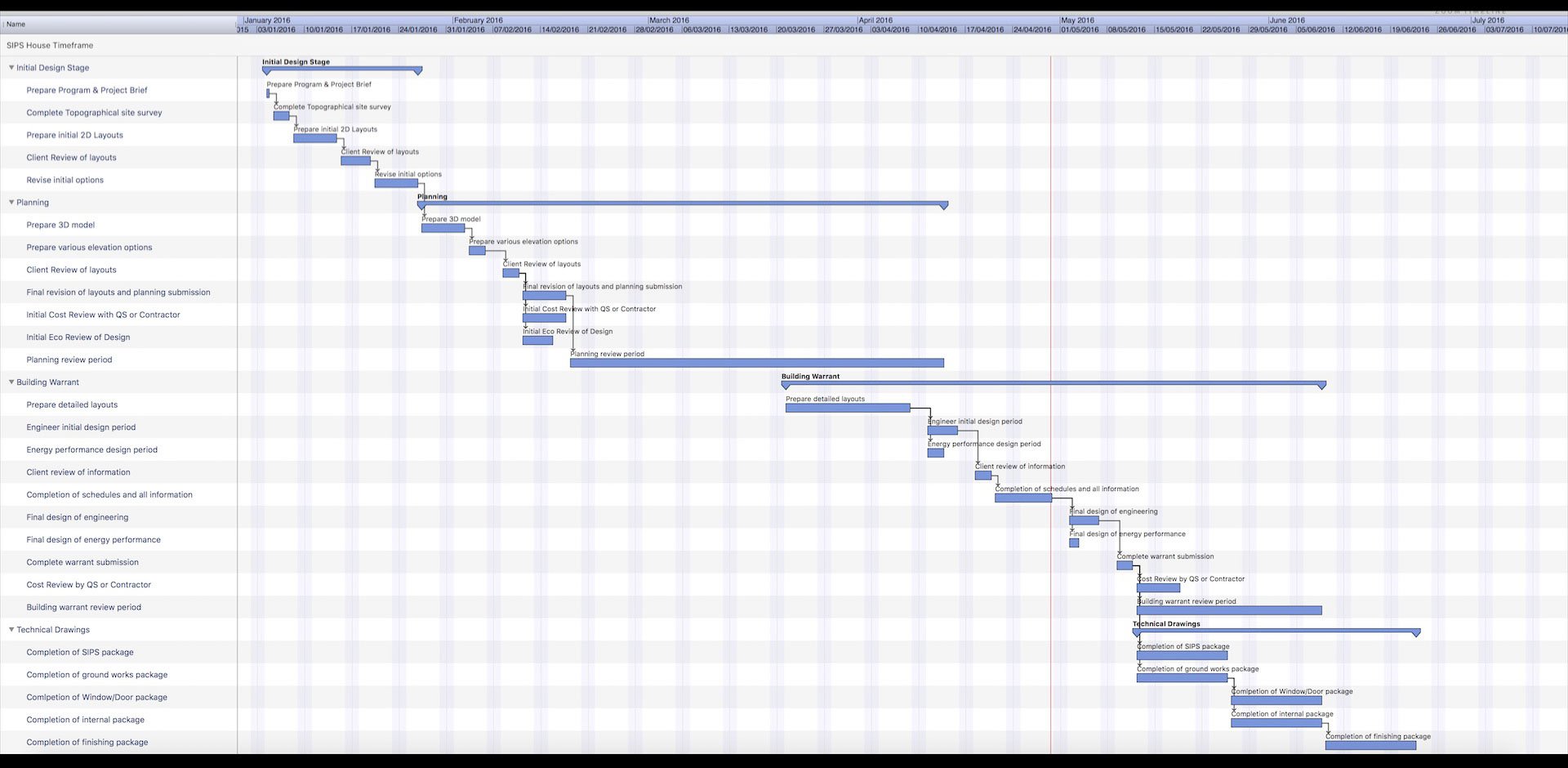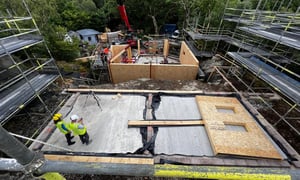If you want to be a successful self-builder – timing truly is everything! Having a structured programme of work in place with all of your professionals scheduled is the only way you can keep your project on track. This article will provide you with a wealth of advice from ACA’s MD, Allan Corfield, on setting up a programme of works.
THE PROJECT FUNDAMENTALS
Once the project’s goals and budget have been established, it's time to look at who is going to make the project happen. The first thing you must understand with self-building, is that if you are going to save money by taking over a professionals role, is that someone must actually do that role! You can’t just decide you are going to do if cheaper than a main contractor and not put the effort it. The main area where self builders can save money is the procurement route – i.e. is it a Turnkey, Project Manager (PM) or self-managed project? With effective time management and patience, Self Builders can replace a professional and save a huge amount of money in the process!
However, this is also an area where things can go badly wrong – if you choose to project manage the build, and cannot commit enough time to the task, then important aspects can be missed out, and the potential for issues on site increases dramatically.
You can find out more about Self Build procurement routes here:
- Hiring A Project Manager For Your Self Build - With Samuel James Project Management
The main part of forming a programme of works is understanding the trades you require, what the scope of their works is, when they need to start, and when they propose to complete their work. When you strip it all back, the vast majority of contractors are really only interested in securing the job, completing the job, getting paid and moving on to the next one.
If you keep this in mind when programming and negotiating prices, you should be able to work well with them – and have happy workers! Always keep in mind that even though it’s worth negotiating on price, if you negotiate too far (i.e. only consider the lowest price), then don’t be surprised if your contractors push your job back for another one or if they are reluctant to help when you need a favour.
A detailed programme of works will allow you to anticipate when to order materials and can help you monitor your cashflow forecast. Putting a work schedule together can be tricky, as you need to get all of your professionals around one table to determine which dates suit each party. So what are the essential elements required in a programme of works?
You should split the programming up into two key sections. The first covers the overall high-level planning of the project – from starting with an architect right up to the site start date. The second part focuses on the onsite management of the build itself. PROGRAMME OF WORKS PART ONE: HIGH-LEVEL PROGRAMMING
PROGRAMME OF WORKS PART ONE: HIGH-LEVEL PROGRAMMING
It’s really important to remember when you start out on your Self Build journey that the overall project may take up to 18 months to complete – and you could add 3-6 months on to this if you have a difficult Planning Approval process!
The average Self Build construction time is around 9-12 months, but this can be completed quicker with the right planning. However, it can also take double the time if you are doing the work yourself!
The best way to plan out programme of works for your project is with a simple Gantt chart (see image). These can be created in Microsoft Project or SG Project Pro for Mac. These cost-effective and simple programmes allow you to enter all of the necessary project stages with associated tasks and assign each of them with a time value.
The tasks are all linked, so if you change the length of time for one stage, it pushes all of the other stages along too. Creating an accurate programme of works is vital, and you should get as much input from all of your professionals as possible.
We would always suggest using achievable timescales for each task, as well as working out a completion date from that – rather than working back the way.
It isn’t uncommon for Self-Builders to pick a big birthday or to aim for Christmas day as a completion date. This isn’t a great idea; trying to fit everything in – rather than sticking to the actual, realistic timescales – will, without a doubt, end in disappointment!
One way to reduce the pre-site programme is to run the Planning and Building Warrant applications in parallel (this can save between 4 and 8 weeks).
This should only be considered if you have had pre-application discussions with the Planners and have a level of certainty of success. Traditionally, you would wait until full Planning has been determined before starting the Building Warrant design drawings.
The key to a successfully managed programme of works is accepting that there will be delays and challenges. Giving some room after each stage will allow for most delays – but you must be able to work around problems and keep the programme fluid! PROGRAMME OF WORKS PART TWO: ONSITE PROGRAMMING
PROGRAMME OF WORKS PART TWO: ONSITE PROGRAMMING
Once you secure the Planning and Building Regulation approvals, you can start to really think about the main part – building your dream home!
The main challenge with site programming is working out when trades need to be on site, how long they need to be there, and if they’ll have an impact on the work of other trades.
By discussing with your chosen contractors exactly what they are going to do and how long it will take, potential mishaps can be avoided.
We would suggest appointing all main trades before you go on site, and get them all around a table for a ‘pre-start site meeting’. The basic trades that need to be appointed (on a standard build) are usually – ground workers, kit manufacturers, roofers, joiners, plumbers, electricians, heating engineers and plasterers.
At this meeting, you can agree on each contractor’s responsibilities and who they are handing over to. Make sure you minute this meeting, and issue it out to all parties as a record of what was agreed. This minute of agreement can be invaluable at a later date if any problems occur.
So, you have everyone in place, and you know how long their jobs will take and in what order they are due to commence – you now need to add this into your Gantt Chart.
If you are building with a pre-fabricated kit (like SIPs or Timber Frame), then you will want your windows to be installed straight after the kit goes up.
Windows take, on average, 6-8 weeks to be fabricated and delivered to the site. Therefore, you would look at the end of the kit erection and go back 6-8 weeks. This gives you the date you must order the windows by! This rule applies to all items, whether it’s big items – like your kitchen or the choice of external brick. Moving back a step further, the windows need to be ordered from a window and doors schedule (provided by your architect), and this must tie in with the kit manufacturing drawings.
Therefore, the importance of completing a detailed programme of works as early as possible is vital!
 ORGANISING THE TRADES
ORGANISING THE TRADES
Another key part of programming is working out who can be on site at the same time; you don’t want to have an over-crowded site which slows everyone down. However, with a bit of clever planning, you can have the roofer working on one side of the building, and the joiner fitting external cladding on the other – but this must be discussed with the relevant trades so that they are aware of the situation, and any potential dangers.
Internally, plumbers and electricians can work together to complete the first fix, but make sure the works are coordinated.
This is so that they can reorganise their other projects accordingly. Keeping your trades happy will make your build easier and will help the overall process run smoothly.
You can find out more about finding reliable tradespeople here.
Creating a programme of works can seem scary or daunting, but work with your professional team and liaise with your contractors. The more people that are involved and informed about the programme of works, the easier it will be for everyone to stick by it – and remember, effective communication throughout the project (by all) will eliminate any potential for bigger problems!




